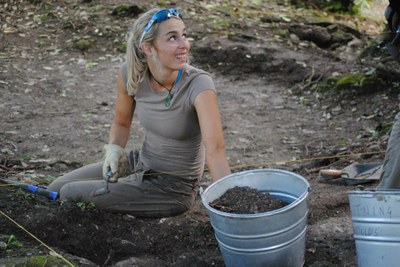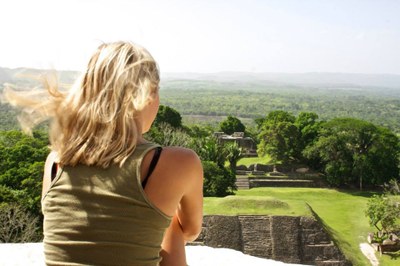Andrea Zorn in Belize
 During the month of June I attended the American Foreign Academic Research (AFAR) 2014 Field School in Belize. It was a shorter field season, lasting 14 days total and I took an extra 4 days at the end of the trip to travel separately. I was one of ten supervisors to American high school students who participated in an archaeological field school on the ancient Maya site of Cahal Pech, located in the Belize River Valley.
During the month of June I attended the American Foreign Academic Research (AFAR) 2014 Field School in Belize. It was a shorter field season, lasting 14 days total and I took an extra 4 days at the end of the trip to travel separately. I was one of ten supervisors to American high school students who participated in an archaeological field school on the ancient Maya site of Cahal Pech, located in the Belize River Valley.
After attending a two month long field season in 2013 with Dr. Jonathan Haws in Portugal, I was excited to get back into the field and gain more experience in a completely different setting. Other supervisors at the AFAR field school included graduate students, CRM professionals, and some of the best Maya scholars.
Cahal Pech is one of the largest sites in the Western Belize River Valley, and consists of a monumental epicenter and a large number of surrounding residential and agricultural features. I was assigned a unit placement and supervised, participated in excavations, and took field notes of the excavation progress. Students participated in the practical work as well as in note-taking every day in order to gain knowledge of the field research process and to complete their field school requirements. There were daily lectures from fellow supervisors on Maya history, previous archaeology in the Belize River Valley, and archaeological research processes. I felt incredibly lucky to gain so much knowledge from the top-leading scholars, and I feel like I gained confidence by teaching archaeological field methods to the students.
During weekends we visited other ancient Maya sites with the students, and I was able to experience Xunantunich, Caracol, Rio Frio Cave, Actun Tunichil Muknal (ATM) Cave, and the Barton Creek Caves. We also visited some of the natural wonders in the Mountain Pine Ridge, swam in the Rio On, and shopped for local produce at the open-air market in San Ignacio. My favorite part of these tours was listening to Dr. Marc Zender discuss the glyphs on stelae and monuments, and relating sites and monuments from all over Guatemala and Belize together to understand the Maya history.
I am so grateful for this amazing experience, and I would like to thank the Hick’s Scholarship for funding me, the Anthropology department for their continuous support during my undergraduate career, AFAR for allowing me to accompany them on their season, and BVAR for their work at archaeological sites in Belize.

